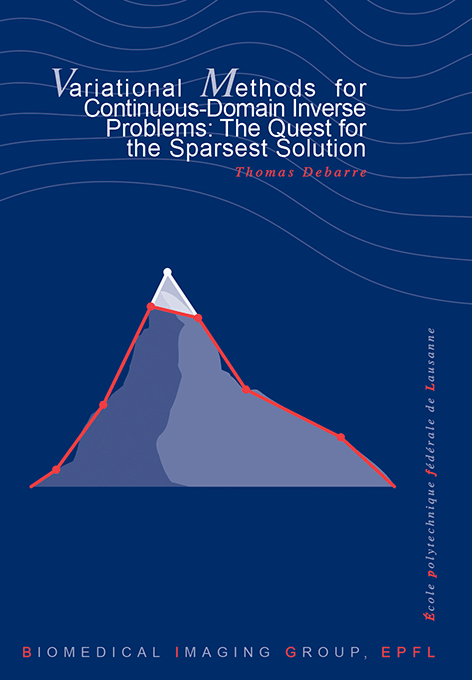Variational Methods for Continuous-Domain Inverse Problems: The Quest for the Sparsest Solution
T. Debarre
École polytechnique fédérale de Lausanne, EPFL Thesis no. 9287 (2022), 373 p., September 16, 2022.
The goal of this thesis is to study continuous-domain inverse problems for the reconstruction of sparse signals and to develop efficient algorithms to solve such problems computationally. The task is to recover a signal of interest as a continuous function from a finite number of measurements. This problem being severely ill-posed, we choose to favor sparse reconstructions. We achieve this by formulating an optimization problem with a regularization term involving the total-variation (TV) norm for measures. However, such problems often lead to nonunique solutions, some of which, contrary to expectations, may not be sparse. This requires particular care to assert that we reach a desired sparse solution.
Our contributions are divided into three parts. In the first part, we propose exact discretization methods for large classes of TV-based problems with generic measurement operators for one-dimensional signals. Our methods are based on representer theorems that state that our problems have spline solutions. Our approach thus consists in performing an exact discretization of the problems in spline bases, and we propose algorithms which ensure that we reach a desired sparse solution. We then extend this approach to signals that are expressed as a sum of components with different characteristics. We either consider signals whose components are sparse in different bases or signals whose first component is sparse, and the other is smooth.
In the second part, we consider more specific TV-based problems and focus on the identification of cases of uniqueness. Moreover, in cases of nonuniqueness, we provide a precise description of the solution set, and more specifically of the sparsest solutions. We then leverage this theoretical study to design efficient algorithms that reach such a solution. In this line, we consider the problem of interpolating one-dimensional data points with second-order TV regularization. We also study this same problem with an added Lipschitz constraint to favor stable solutions. Finally, we consider the problem of the recovery of periodic splines with low-frequency Fourier measurements, which we prove to always have a unique solution.
In the third and final part, we apply our sparsity-based frameworks to various real-world problems. Our first application is a method for the fitting of sparse curves to contour data. Finally, we propose an image-reconstruction method for scanning transmission X-ray microscopy.

@PHDTHESIS(http://bigwww.epfl.ch/publications/debarre2202.html,
AUTHOR="Debarre, T.",
TITLE="Variational Methods for Continuous-Domain Inverse Problems: {T}he
Quest for the Sparsest Solution",
SCHOOL="{\'{E}}cole polytechnique f{\'{e}}d{\'{e}}rale de {L}ausanne
({EPFL})",
YEAR="2022",
type="{EPFL} Thesis no.\ 9287 (2022), 373 p.",
address="",
month="September 16,",
note="")